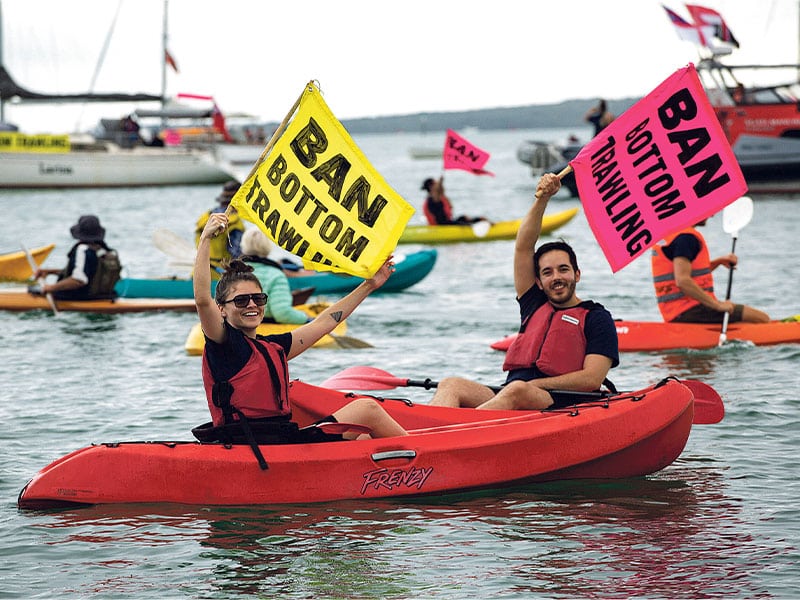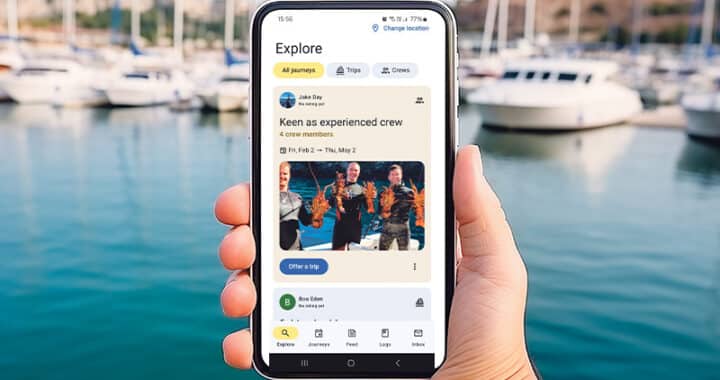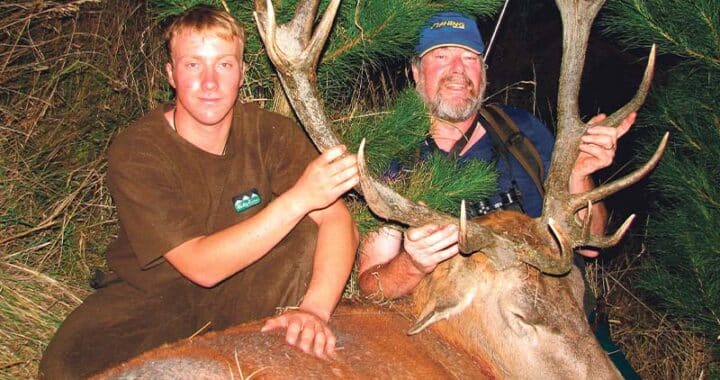Trawling in Auckland’s Hauraki Gulf remains under scrutiny
5 min read
The event was organised by Greenpeace Aotearoa and Forest & Bird. Photo: Byrce Groves | Greenpeace
At the end of April, hundreds of people took to kayaks, paddleboards, and boats on Auckland’s Hauraki Gulf to call for an end to bottom trawling. Trawlers in the Gulf most commonly target snapper, tarakihi, trevally, and John Dory, as well as species such as scampi and hoki in a small area that encompasses deep-water environments. Trawling has numerous spatial restrictions within the Gulf under current fisheries regulations and it is prohibited in the inner Gulf from any size vessel.
The demonstration, which included a massive ‘ban bottom trawling’ banner, was organised by Greenpeace Aotearoa and Forest & Bird, in the waters just off Mission Bay.
“Trawling has no place in this precious marine park and the public mandate for change is clear – over 84% of people surveyed want trawling gone from the Gulf,” Greenpeace oceans campaigner Ellie Hooper said.
“It’s time the Government listens and bans bottom trawling so the Gulf can recover.”
The first known exploration of trawling in the Gulf dates back to 1881 when a trawl net was dropped between Tiritiri Matangi and Cape Colville.
According to the Hauraki Gulf Alliance, most bottom trawling occurs in the outer gulf, with around 17% of fish commercially caught by bottom trawl methods. It said it takes at least seven years for a trawled or dredged seafloor area to recover. The WWF meanwhile, said the Gulf ecosystem was in a far worse state now than it was when the Hauraki Gulf Marine Park was established 20 years ago.
“There are widespread kina barrens, significant benthic (anything associated with or occurring on the bottom of a body of water) habitat loss, overfishing is occurring, tarakihi, and bait fish are in trouble, rock lobster have been defined as functionally extinct due to commercial overfishing, and many shellfish species have collapsed,” the organisation said. “These mobile bottom contact fishing methods drag fishing gear across the seafloor, destroying valuable benthic habitats in the process. These methods are also indiscriminate and catch large amounts of untargeted sea life and bycatch.
“The effects of these harmful fishing methods are long-lasting, and it takes years for seafloor area to recover. The Government needs to step up and be bold, ban trawling and dredging from the entire Marine Park.”
The government response

The fight to protect the seafloor of the Gulf from bottom trawling has been going on for more than a century when the Government was first petitioned with the arrival of the first steam trawlers in 1899.
The most significant win was a protected part of the inner Gulf that predated the Hauraki Gulf Marine Park Act 2000. This was followed by the Sea Change – Tai Timu Tai Pari Marine Spatial Plan 2017, which sought the transition to seabed-friendly fishing methods by phasing out bottom trawling and Danish seining in the marine park.
The issues highlighted by the Sea Change Plan relating to the state of fisheries resources in the Hauraki Gulf included mobile bottom-contact fishing methods such as bottom trawling, Danish seining and dredging have changed benthic (seafloor) habitats in the Gulf, reducing benthic biodiversity, and modifying species’ interactions. In June 2021, the Government released its Revitalising the Gulf: Government action on the Sea Change Plan strategy in response to the Sea Change plan.
The strategy set out a package of marine conservation and fisheries management actions to restore the Hauraki Gulf. The draft plan proposed a range of integrated management actions, including removing bottom trawling and Danish seine fishing except within limited areas, or “trawl corridors”.
“To support the recovery of species and habitats, we propose new marine protected areas in some of the most biodiverse regions in the Gulf and complementary sustainable fisheries management measures, including harvesting controls and restrictions on trawling,” the report said.
“Establishing trawl corridors is a management action in the draft plan, signalling the commitment to progressing this key piece of work. This action is part of a suite of measures within the plan to help achieve the objectives and long-term desired outcomes for fisheries in the Hauraki Gulf.”
The report said excluding these methods from the Gulf could affect consumers who access and rely on lower-cost fish because both bottom trawl and Danish seine fisheries provide a lower-cost product due to their efficiency.
“Transitioning bottom-contact fisheries to other methods or areas could, therefore, have economic consequences that must be carefully considered,” it said.
However, Forest & Bird Hauraki Gulf coordinator Bianca Ranson says removing the pressure of bottom trawling is a no-brainer.
“The Sea Change proposal recommended the removal of bottom trawling, yet the Government has chosen to forge ahead with leaving vast areas of the Gulf open to destruction,” she said.
“Right now, the Government is considering decisions that will determine if the Gulf thrives or declines further into ecological collapse. We’re here to tell the Government to listen to the tens of thousands of people who want protection and not be influenced by fishing industry lobbyists. We need to protect the Gulf, not the interests of the fishing industry.”
A collaborative approach?

Meanwhile, Seafood New Zealand chief executive Jeremy Helson said he was concerned that the ‘Show Your Heart for Hauraki’ protest had a limited focus and was unhelpful to the shared vision of a healthy Hauraki Gulf.
“To really make positive improvements in the Gulf, there needs to be a generational change and a Ki uta ki tai – mountains-to-sea approach is needed,” he said.
“The Ministry for Primary Industries has said the main threats to the Gulf are a multitude of things – population growth, development and intensification of land use, land-use practices that result in significant sediment loads, nutrients, pathogens, marine debris, and other contaminants, ageing infrastructure, increasing ship and boat numbers, commercial and recreational fishing, and marine pests.
“Yes, commercial fishing is and has been one of the pressures on the Gulf. But commercial fishers have significantly changed how they fish since the mid-1980s, when inshore finfish stocks, including those in the Gulf, were in a perilous state.
“The number of fishing vessels has reduced, technology and fishing gear has improved, and the increase in healthy fish stocks, thanks to the Quota Management System and management targets, mean fishers are able to stick to the adapted, sandy-bottomed fishing grounds in the Gulf, avoiding areas rich in biodiversity.”
An estimated 50% of fish commercially caught in the Gulf is sold to Aucklanders – in restaurants, fish shops, and takeaway shops.
“Commercial fishing is not, and would never, shirk its own responsibilities, but unless effective action also takes place on the land, all the other actions will have little effect,” Helson said.
“This is what we should be asking the Government and councils for, an ecosystem-based approach that addresses all stressors on the Gulf, in proportion to the risk each poses.”



